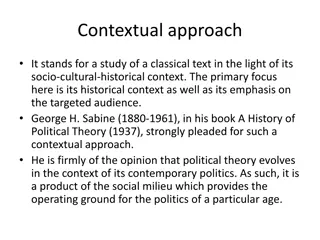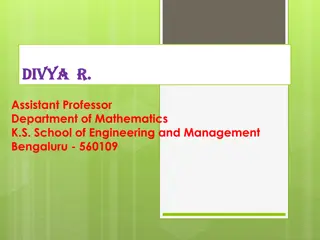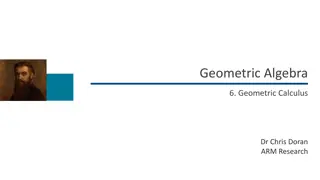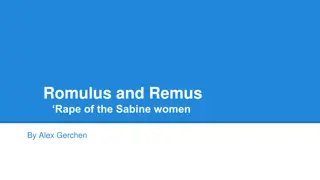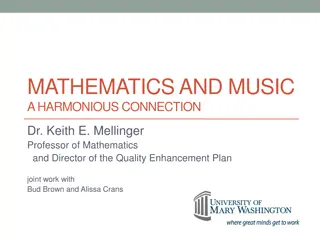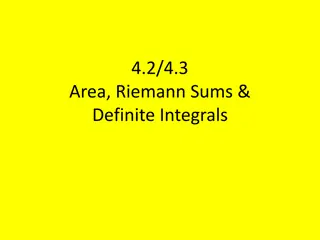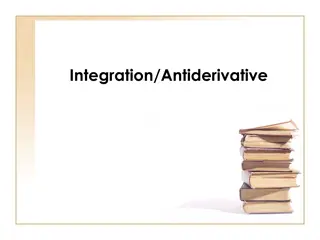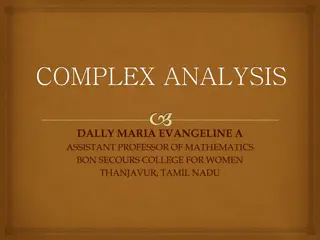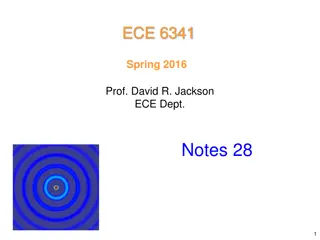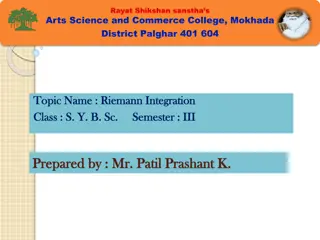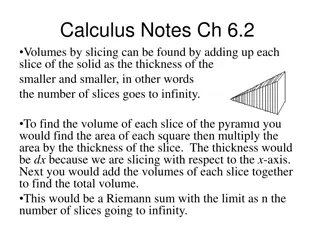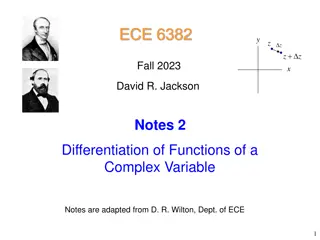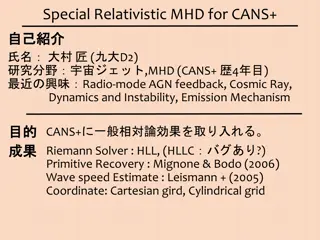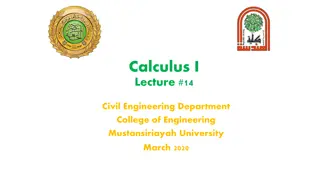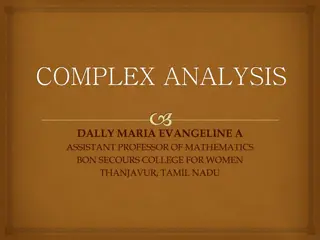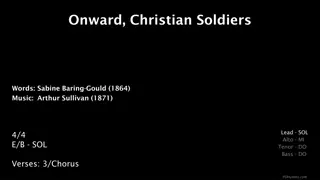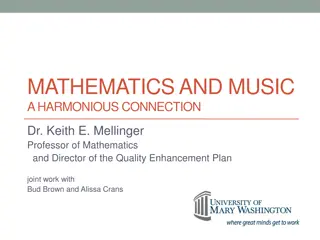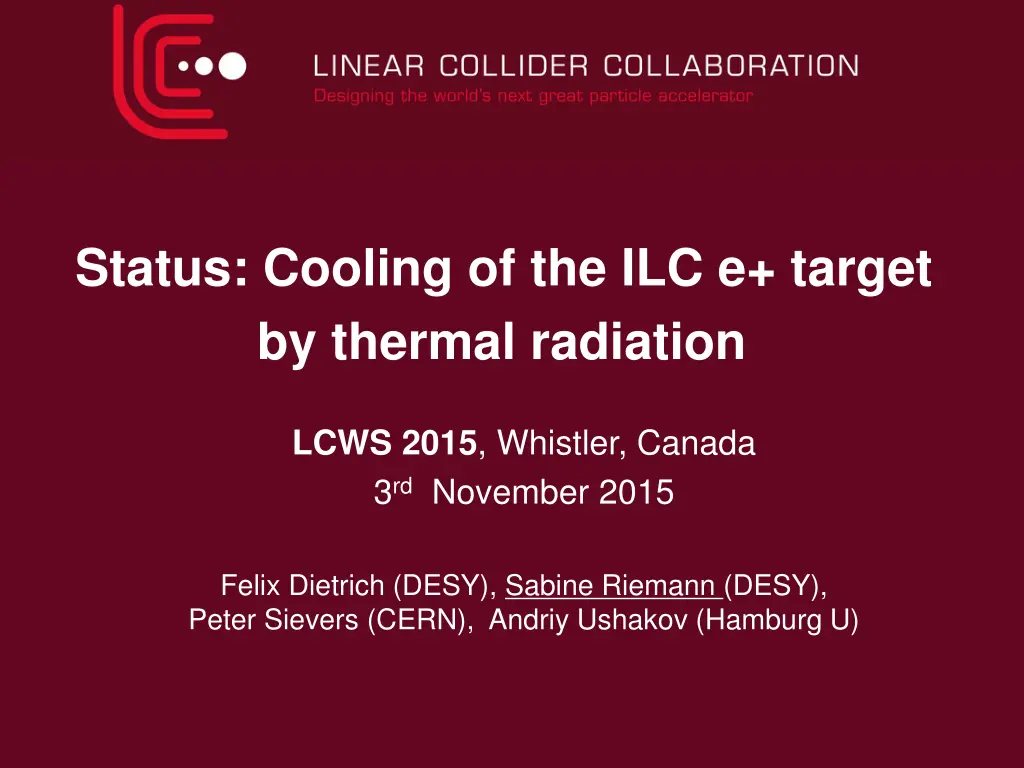
Radiative Thermal Cooling of ILC e+ Target
Learn about the status of radiative thermal cooling for the ILC e+ target, including design considerations, mechanical issues, and future steps discussed at LCWS 2015 in Whistler, Canada. Felix Dietrich, Sabine Riemann, Peter Sievers, and Andriy Ushakov presented on the cooling process involving thermal radiation, Ecm energy levels, luminosity factors, and the importance of the target wheel design for efficient energy dissipation.
Download Presentation

Please find below an Image/Link to download the presentation.
The content on the website is provided AS IS for your information and personal use only. It may not be sold, licensed, or shared on other websites without obtaining consent from the author. If you encounter any issues during the download, it is possible that the publisher has removed the file from their server.
You are allowed to download the files provided on this website for personal or commercial use, subject to the condition that they are used lawfully. All files are the property of their respective owners.
The content on the website is provided AS IS for your information and personal use only. It may not be sold, licensed, or shared on other websites without obtaining consent from the author.
E N D
Presentation Transcript
Status: Cooling of the ILC e+ target by thermal radiation LCWS2015, Whistler, Canada 3rd November 2015 Felix Dietrich (DESY), Sabine Riemann (DESY), Peter Sievers (CERN), Andriy Ushakov (Hamburg U)
Outline Radiative thermal cooling of e+ target Status Target temperature distribution Design considerations mechanical issues Our next steps Summary 2 LCWS 2015: Status radiative thermal e+ target cooling Riemann, Dietrich, Sievers, Ushakov
e+ target for Ecm= 250 500GeV Ecm and luminosity determine energy depsited in target (Pe+ 30%) Ebeam [GeV] Nominal luminosity 120 5.0 66 2015 Tmax/pulse [K] Tmax/pulse [K] Edep [kW] Edep [kW] High luminosity A. Ushakov, - - 175 (ILC EDMS) 250 (ILC EDMS) 250 Update 2015 3.9 2.0 2.3 125 130 85 - - 4.1 4.6 195 165 A. Ushakov, Target wheel design appropriate for all Ecm ? radiative surface A sufficient to remove deposited energies W for all Ecm? ( ) 4 radiator T 4 cool P ~ A T Thermal contact Ti-Cu radiator is important 3 LCWS 2015: Status radiative thermal e+ target cooling Riemann, Dietrich, Sievers, Ushakov
Area A of thermal radiation ( ) = = 4 radiator T 4 cool P Q GA T = Stefan-Boltzmann constant = 5.67 10-8 W/(m2K4) = emissivity = 0.7 G = geometric form factor = 1 Target wheel r = 0.5m Simple full disk 1.6m2 T[ C] A[m2] 4 LCWS 2015: Status radiative thermal e+ target cooling Riemann, Dietrich, Sievers, Ushakov
Radiative cooling considered so far e+ target located very close to the optical matching device Rotating target wheel consists of Ti rim (e+ target) and Cu (radiator) Heat path: thermal conduction Ti Cu wheel Thermal radiation from Cu to stationary water cooled coolers Target, radiator and cooler are in vacuum Cooling area can be easily increased by additional fins Target position must be close to OMD Felix Dietrich 5 LCWS 2015: Status radiative thermal e+ target cooling Riemann, Dietrich, Sievers, Ushakov
So far, Felix considered a cooling area of 2.8 m2 near the target created by 2 7 fins (length of fin is 3cm, height 0.5cm) Including almost full disc in radiative cooling, max temperature in target decreases Max average temperature in target goes down with area: Design (fins) must be optimized to avoid mechanical problems/stress at high rotation speed 6 LCWS 2015: Status radiative thermal e+ target cooling Riemann, Dietrich, Sievers, Ushakov
So far, Felix considered a cooling area of 2.8 m2 near the target created by 2 7 fins (length of fin is 3cm, height 0.5cm) Including almost full disc in radiative cooling, max temperature in target decreases Max average temperature in target goes down with area: 1 T T A = 4 A Design (fins) must be optimized to avoid mechanical problems/stress at high rotation speed 7 LCWS 2015: Status radiative thermal e+ target cooling Riemann, Dietrich, Sievers, Ushakov
Design issues Temperature distrubution Heat transfer from target to radiator Titanium has a low heat conductivity maximum and average temperatures in Ti Ti-Cu contact Stress Stress in Ti target rim thermal expansion of Ti, Cu Optimum design of radiator 8 LCWS 2015: Status radiative thermal e+ target cooling Riemann, Dietrich, Sievers, Ushakov
Ti Heat transfer in the target Temperature distribution in target depends on deposited energy Target parameters (material, size,..) PEDD Tmax = 120K / 200K (nominal / high lumi) Speed of heat transfer determines Average temperature in target time until equilibrium temperature is reached Depends on thermal conductivity : Ti target Photon beam hits after ~7seconds the same position at the target Thermal diffusion vs time: xTi = 0.68 cm for 7s; 2.2 cm for 70s xCu = 2.8 cm for 7s; 9.0 cm for 70s 7s are not sufficient to remove the heat from target temperature accumulates over many bunch trains up to equilibrium Temperature gradient from beam path area to contact surface to radiator Cu = x t c 9 LCWS 2015: Status radiative thermal e+ target cooling Riemann, Dietrich, Sievers, Ushakov
Heat flux through Ti-Cu contact Consider 2 options: (see also Felix Dietrich s talk at POSIPOL 2015) 1. a = 5cm 2. a = 4cm Temperature distribution along the target Temperature distribution along Ti Cu contact Ti a Cu 2 cm 10 LCWS 2015: Status radiative thermal e+ target cooling Riemann, Dietrich, Sievers, Ushakov
Temperature distribution in the target after 903s (128 bunch trains hit the same target area, shortly before 129th) Target height a = 5cm Tmax = 414 C Target height a = 4cm Tmax = 307 C 11 LCWS 2015: Status radiative thermal e+ target cooling Riemann, Dietrich, Sievers, Ushakov
Heat distribution in Ti target Consider 2 options (see also Felix Dietrich s talk at POSIPOL 2015) 1. a = 5cm 2. a = 4cm Temp along the target (896s) 128 pulses at same target area P = 2.3 kW, Cu = Ti = 0.7 Ti a Cu 2 cm Ti a = 4cm a = 5cm 12 LCWS 2015: Status radiative thermal e+ target cooling Riemann, Dietrich, Sievers, Ushakov
Heat distribution along Ti-Cu contact Consider 2 options (see also Felix Dietrich s talk at POSIPOL 2015) 1. a = 5cm 2. a = 4cm Temp along Ti-Cu contact (896s) 128 pulses at same target area P = 2.3 kW, Cu = Ti = 0.7 Ti Cu a 2 cm a = 4cm a = 5cm Ti Ti Cu Cu 13 LCWS 2015: Status radiative thermal e+ target cooling Riemann, Dietrich, Sievers, Ushakov
Equilibrium temperature in the target Temperature evolution over time, ANSYS Ecm = 500GeV; Edep = 2.3 kW Radiator area ~2.8 m2 Felix Dietrich Ti Cu a Max average temperature in Ti target (area along beam path) 2 cm a = 5cm a = 4cm After ~3 hours equilibrium temperature distribution reached height a max temperature Tmax 680 C (a = 5cm) Tmax 570 C (a = 4cm) Distance beam path to Ti-Cu contactis important Temperature in Cu (near Ti) 280 C (a = 5cm), 270 C (a = 4cm) 14 LCWS 2015: Status radiative thermal e+ target cooling Riemann, Dietrich, Sievers, Ushakov
Temperature distribution at the target rim adjust revolution frequency to distribute energy deposition almost uniformly over rim for example: bunch train occupies angular range pulse frev = 1922rpm instead of 2000rpm pattern: 1st second: 0, 144, 288, 72, 216, 2nd second: 0 + pulse ., 3rd second: 0 +2 pulse . after ~7s the rim is almost uniformly heated unbalances due to non-uniform heating are avoided 15 LCWS 2015: Status radiative thermal e+ target cooling Riemann, Dietrich, Sievers, Ushakov
Lower rotation speed? F. Staufenbiel et al.: assuming water cooling channels, 1500rpm or even 1000rpm seems possible in case of nominal luminosity @Ecm=500GeV Radiative cooling is slower due to value and longer heat transfer distances even higher average temperature in the rim for lower rotation speed spinning with about 2000rpm for radiation cooling M. Jenkins @ POSIPOL15 considered realistic undulator. Peak intensity of photon beam may be lower; this could help studies needed 16 LCWS 2015: Status radiative thermal e+ target cooling Riemann, Dietrich, Sievers, Ushakov
Stress consideration in Ti rim Thermal due to energy deposition in Ti rim Cyclic load from photon beam: ~ 250MPa Thermal stress ANSYS simulations (A. Ushakov): thermal 10 - 20MPa Stress due to centrifugal force: Hoop stress in thin ring: H 2 r2= 50MPa Properties of Ti alloy: Tensile yield strength: 880MPa Compressive yield strength: 970MPa Elongation at break: 14% fatigue strength at 107 load cycles: 510MPa (unnotched) This value is based only mechanical load. Material modification due to irradiation and heating are not taken into account Degradation of heated Ti alloy due to cyclic load should be tested 17 LCWS 2015: Status radiative thermal e+ target cooling Riemann, Dietrich, Sievers, Ushakov
Stress at Ti-Cu contact Thermal expansion and resulting distortion stress at the Ti-Cu contact depends on temperature profile in radiator and target Ti = 8.6 10-6/K Cu = 16.5 10-6/K Max temperature in Ti wheel ~500 C Max temperature in Cu radiator (near Ti-Cu contact) is ~200 C 0.33% ( 1mm) h ~ 0.43% (0.2mm) r ~ ANSYS simulation (prel.) by A. Ushakov: assumed brazed Ti-Cu contact P= 5170W, Cu = 0.7, Ti = 0.25 v.Mises stress < 200MPa Additionally, stress due to centrifugal force Not yet taken into accouSurface roughness Contact pressure Are there substances, vacuum-capable, to minimize thermal resistance? P. Sievers: bolting at 10 MPa could allow frictionless, lateral thermal expansion maintaining the thermal contact bolting is ok, brazing is not ok Still to be done: implement real contact in ANSYS simulations. LCWS 2015: Status radiative thermal e+ target cooling 18 Riemann, Dietrich, Sievers, Ushakov
Radiator: Mechanical aspects and stress Mass of the wheel (Cu radiator) ~100 kg For comparison: 1.5cm thick Ti disk ~55kg Energy E stored in the wheel O( 0.5MJ) Stress at the (long) radiator fins due to centrifugal force mass of one fin (3cm long): 3kg Hoop stress in fins: : H= 2 r2 80MPa Stress at fin disc connection Not yet considered: deformation of fins due to thermal distribution and centrifugal force Under study: fins with trapezoidal shape Performance concerning cooling parameters Stress in radiator 19 LCWS 2015: Status radiative thermal e+ target cooling Riemann, Dietrich, Sievers, Ushakov
Distribution, number and shape of fins is decisive for cooling power Design with long outer fins is not the optimum concerning mechanical properties of the spinning wheel Example: distribute n fins (trapezoidal shape) on radiator disk area for radiation cooling, mass of all fins temperature distribution in target, mech. issues, n Trapez a/b/h [cm] 2.15 / 0.42 / 1.5 1.3 / 0.4 / 1.5 1.04 / 0.27 / 1.0 A Mall Fins [kg] 30.3 38.4 28.5 16 18 [m2] 2.1 2.6 2.3 12 h b a 20 LCWS 2015: Status radiative thermal e+ target cooling Riemann, Dietrich, Sievers, Ushakov
In principle, Ti keeps its stability in the temperature range 200 - 635C (http://form-technik.biz/titan-material-eigenschaften/) Stability of Cu decreases with temperature, but this shouldn t be a problem for T ~ 200 and choice of special alloy Permanent stress due to tangential force to be checked Thermal expansion slightly changed momentum of inertia wheel slows down slightly if no correction Non-uniform average temperatures, deformations around the wheel unbalances All unbalances have to be monitored and corrected; has to be discussed with engineers Long term material degradation due to irradiation must be tested experimentally Target material tests German Ministry of Science supports work for intense sources; period: July 2015 2019 (manpower), collaboration of U HH, U Mainz, U Darmstadt and DESY Simulation of cyclic load at Mainz using e- beam (MAMI, later MESA facility) Collaboration with Mainz U and Darmstadt U creeping effects ? 21 LCWS 2015: Status radiative thermal e+ target cooling Riemann, Dietrich, Sievers, Ushakov
Our next steps @ DESY/ U Hamburg Temperature evolution in the whole system (including optimized shape of fins) stress at the target + radiator wheel optimize system to be flexible for all energies and luminosities Thermal contact target-radiator Aspects important for magnetic bearings (forces, imbalances, ) Figure out safety factors for long-term operation Material tests in collaboration with U Mainz 22 LCWS 2015: Status radiative thermal e+ target cooling Riemann, Dietrich, Sievers, Ushakov
Summary Radiative cooling will work, no showstopper identified see also POSIPOL15 Scheme is under study & optimization Prototyping: Desired: design an experimental mock up in real size DESY/Uni HH: no hardware resources Experience of ANL/China R&D is very helpful Material tests at Mainz (e- beam) Also important and has to be done: polarization issues Upgrade to higher polarization: photon collimation Realistic undulator B field ( PEDD in target, polarization) Our Resources at DESY and Uni HH are unchanged since POSIPOL15 Ideas and support are highly welcome 23 LCWS 2015: Status radiative thermal e+ target cooling Riemann, Dietrich, Sievers, Ushakov
Thank you! 24 LCWS 2015: Status radiative thermal e+ target cooling Riemann, Dietrich, Sievers, Ushakov

